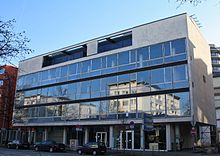Otto Apel
Otto Apel (born December 30, 1906 in Vatterode ; † March 19, 1966 in Frankfurt am Main ) was a German architect .
Life
After an apprenticeship as a bricklayer, Otto Apel began an apprenticeship in an architecture office and studied at the building trade school in Kassel from 1925 to 1927 . He then worked as a technical employee for the city of Kassel before starting his studies at the Academy of Arts in Berlin in 1929.
During National Socialism he was an architect at the General Building Inspectorate in Berlin as assistant to Heinrich Tessenow on Albert Speer's architectural staff . In the last years of the war he was drafted as a soldier.
In the post-war period, Apel was the lead architect at Frankfurter Aufbau AG with numerous reconstruction projects for office buildings and apartments for federal employees. From 1949 he worked as a freelance architect in a joint venture with Rudolf Letocha , Rohrer, Herdt and Sep Ruf , on the extension buildings and the settlements of the US High Commission (HICOG) in Bonn and Bad Godesberg ( Muffendorf , Plittersdorf and Tannenbusch ), until he did 1953 opened his own architectural office in Frankfurt. At times he also worked with Eberhard Brandl and with the New York office of Skidmore, Owings & Merrill . In 1961 he founded the architecture office ABB together with Hannsgeorg Beckert and the engineer Gilbert Becker .
Apels buildings are at the transition from Nazi architecture to modernist architecture of the 1950s, when a connection to the international architectural trends (e.g. Le Corbusier ) was sought. Typical of his style are protruding cornices and slender window frames made of aluminum with gold anodized profiles.
Work (selection)

- 1951: HICOG administration building in Bad Godesberg (with Sep Ruf, Letocha, Rohrer and Herdt)
- 1952: HICOG settlement in Bad Godesberg-Plittersdorf (with Sep Ruf, Letocha, Rohrer and Herdt)
- 1952: HICOG settlement Muffendorf / Pennenfeld (with Sep Ruf, Letocha, Rohrer and Herdt)
- 1953: Student house (today student house Mertonstraße 28), Frankfurt am Main (with Letocha, Rohrer)
- 1953–1956: Consulate General of the USA in Düsseldorf (with Skidmore, Owings and Merrill )
- 1954–1955: Former US consulate in Stuttgart
- 1955: Former US Consulate General in Siesmayerstraße in Frankfurt am Main (with Skidmore, Owings & Merrill )
- 1956: Office and residential building at Berliner Straße 25 in Frankfurt am Main
- 1956: School and kindergarten in the HICOG settlement in Plittersdorf.
- 1957–63: Double theater, drama, Kammerspiele and Frankfurt Opera , with Beckert and Becker.
- 1958: America House (with Skidmore Owings & Merrill).
- 1960: Opera house in Essen (with Hannsgeorg Beckert; design).
- 1962–1968: Northwest Center in the Northwest City (ABB, urban planning Sittmann and Schwagenscheidt ).
- 1963: InterContinental Frankfurt , with Beckert and Becker.
- 1963–1965, together with Beckert and Becker: Hotel Intercontinental Hannover on Friedrichswall in Hannover .
- 1967–1972, posthumously : Headquarters of the Deutsche Bundesbank in Frankfurt am Main.
Web links
- Otto Apel. In: arch INFORM .
- Sunna Gailhofer: banks, stages, hangars. Frankfurt projects by Otto Apel / ABB Architects . 2018. [1]
- http://zukunft-buehnen-frankfurt.de/2020/04/07/die-architektur-von-abb/
Individual evidence
- ↑ Biography: Otto Apel (architect). In: The Berlin government district. Archived from the original on December 13, 2013 ; accessed on August 9, 2016 .
- ^ The architecture of ABB - Future City Theaters Frankfurt. Accessed June 7, 2020 (German).
- ↑ Helmut Knocke , Hugo Thielen : Friedrichswall 11 , in Dirk Böttcher , Klaus Mlynek (ed.): Hannover. Kunst- und Kultur-Lexikon (HKuKL), new edition, 4th, updated and expanded edition, Springe: zu Klampen, 2007, ISBN 978-3-934920-53-8 , p. 114
| personal data | |
|---|---|
| SURNAME | Apel, Otto |
| BRIEF DESCRIPTION | German architect |
| DATE OF BIRTH | December 30, 1906 |
| PLACE OF BIRTH | Vatterode |
| DATE OF DEATH | March 19, 1966 |
| Place of death | Frankfurt am Main |